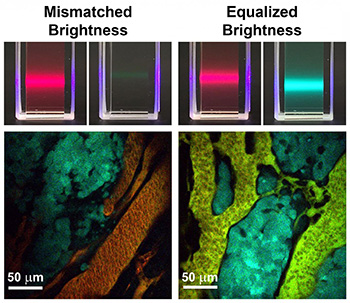
When administered to a tumor to measure molecular concentrations, the signals from conventional fluorescent dyes are dominated by the brighter fluorophores (left). Brightness-equalized quantum dots have equal fluorescence brightness for different colors, allowing measurement of many molecules at the same time (right). Credit: University of Illinois
A U.S.-based team of biomedical engineers has introduced a new class of light-emitting quantum dots (QDs) with customizable brightness and color. The authors say that their QDs’ fluorescence can be tuned and equalized across a broad range of colors in the visible and near-infrared, which could allow for more accurate and quantifiable measurements at the molecular level in biological tissue imaging (Nat. Commun., doi: 10.1038/ncomms9210).
Corresponding author Andrew Smith, from the University of Illinois at Urbana-Champaign (USA), says that the varying photon emission rates in commonly used fluorescent probes—including size-tuned QDs—have an “unknown correspondence with molecular number,” which means that they can’t be used to reliably quantify molecular concentration because they have mismatched brightness. The new class of QDs demonstrated by Smith and his colleagues offer equalized brightness across a wide range of colors, theoretically making it possible to derive several different molecular concentrations based on the light intensity from one image.
The new QDs have a three-domain core-shell-shell structure. The compartmentalized structure is key to decoupling the emission wavelength, extinction coefficient, and quantum yield parameters, allowing each of them to “derive from independent structural domains in the nanocrystal.” The QD cores are made from an alloy with continuously tunable bulk band gaps. The adjustable band gap material gives the researchers control over a QD’s emission wavelength without having to change the size of the core. And because the cores are the same size, they have “intrinsically similar” extinction coefficients. Finally, quantum yield is normalized by the wide-band-gap ZnS in the outermost shell.
The researchers demonstrated normalized brightness for their core-shell-shell QDs emitting across a wavelength range of 500 to 800 nm with excitation between 350 and 450 nm. They observed brightness equalization under two-photon excitation conditions, which, they say, could translate into improved quantitative imaging in biological tissue.
